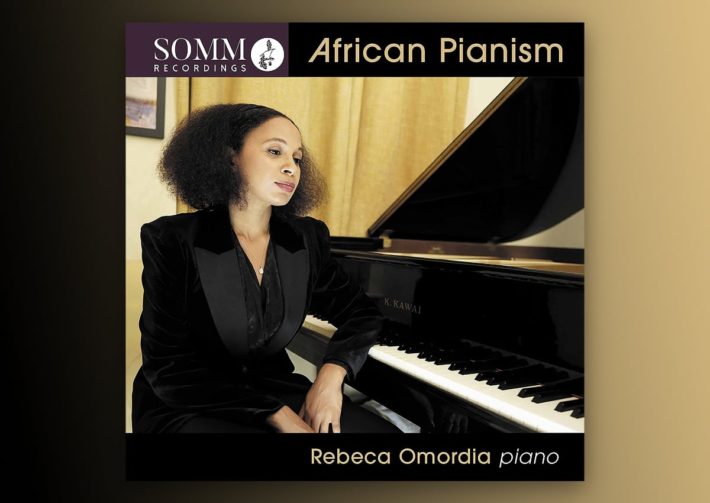When I first heard about Rebeca Omordia’s new release, I was immediately intrigued: rarely does one find an album that bridges elements of African musical tradition with an instrument of European roots. Indeed, African ‘art music’ (as the liner notes describe) has only started to gain wider exposure in the 21st century. The composers whom Omordia features hail from different parts of the continent: Nigeria, Ghana, Morocco, and South Africa. Their music finds a range of inspirations from Nigerian drumming to Kurd melodies.
Ayo Bankole’s Egun Variations (track 1) is well-placed as the opening selection. Integrating an Egun song, Tona Nowe, into a G major diatonic framework, the work will both welcome and fascinate listeners. The theme (0:00-1:33), with its ostinato accompaniment of open intervals, sounds almost like a hymn–a nod, maybe, to Bankole’s influences? (His father was an organist and choirmaster). Omordio plays the melody with a sense of calm, but its fluidity also reminds us of a voice. The first variation derives its expansive character from the rolling arpeggios, while the second (2’22”) is coy but playful. The third’s meandering treble introduces a lyrical character with touches of chromatic color. The minor key variation (4’16”) I found the most adventurous in how it juxtaposes ominous, atonal harmonies with more melodious interludes. What follows is an almost unexpected climactic point: a virtuosic flurry that ends with a series of piercing chords before returning to the opening material, now in a minor key–reflective yet somehow mysterious.
Among several world premiers on disc are Fred Onovwerosuoke’s Five Kaleidoscopes for Piano (2013), which Omordia herself commissioned. The first selection, With vigor, has a buzzing motif and angular melody to convey suspense and an element of danger. The playing here could perhaps use a sharper edge in places but it’s nevertheless effective. The ballade-like Larghetto espressivo (track 11) is about both the joy of love and love for a homeland. Omordia’s mellifluous performance evokes longing, warmth, and comfort. The final Vivace con brio is what Onovwerosuoke describes as a “frantic hunt for shelter” from a storm. For all of its prevalent rhythmic drive, there is a sense of tumult in the pointed dissonances.
Related Posts
- Review: George Walker – Five Piano Sonatas – Steven Beck, Piano
- Review: Florence Price – Symphonies 1 & 3 – Nézet-Séguin
- Review: Dreams of a New day – Will Liverman, Paul Sánchez
David Earl’s Princess Rainbow (track 14) is taken from his suite, Scenes from a South African Childhood. Inspired by a bedtime story Earl’s father would recount, the work has some captivating elements – we get a bit of Ravel’s shimmer that Omordia adds just the right amount of urgency to. I also caught some influences of film music: the outer sections would not seem at all misplaced in a cinematic shot of a small, gushing river. The middle section, with its atonality and chromaticism, offers a brief respite but one that doesn’t let us get too complacently calm.
Nabil Benabdeljalil’s selected Nocturnes are also world premieres, of which I found VI (track 17) particularly dynamic. Benabdeljalil mentions how its conception came after a journey through the mountains of Morocco; while the piece signifies “freedom found in nature,” it also represents a spiritual journey. Despite aligning with stylistic elements of a nocturne, the essence of the inspiration is front-and-center: long, fluid lines wander, sometimes almost in a dream-like fashion. The conclusion serves as a cataclysmic peak before slipping away enigmatically.
I also enjoyed the final set, Akin Euba’s 3 Yoruba Songs Without Words. In Ore meta (track 19), featuring both Nigerian drums and piano, Euba sought to reveal the similarities a traditional instrument has with a Western one in expressive capabilities. As different as these vehicles are, this performance (with Abdelkader Saadoun on drums) shows their seamless compatibility. Where the piano has warm harmonies, the drums possess the visceral energy and drive. The performers are well-coordinated throughout, not just rhythmically but also in the shading of their dynamic gradients.
Robert Matthew-Walker’s generous liner notes provide informative descriptions of the composers and each work. What I found especially impactful was the introduction that gave context for the recital’s theme and that highlighted the importance of ethnicity as a core of musical expression. African Pianism is not only well-presented but also illuminating. My takeaway is that we need more albums like this: ones that will bring us beyond what’s familiar so that we can expand our appreciation of an unbounded musical horizon.

African Pianism
Rebeca Omordia – Piano
SOMM Recordings, SOMMCD 0647
Related Albums
Read more classical music reviews or visit The Classic Review Amazon store
Follow Us and Comment:
Get our periodic classical music newsletter with our recent reviews, news and beginners guides.
We respect your privacy.









